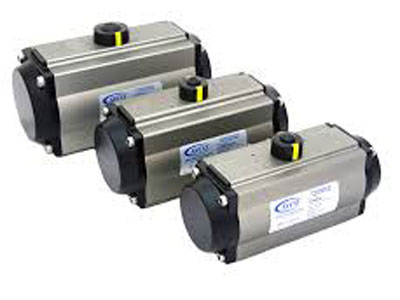What Are The Different Types Of Pneumatic Valve Actuators?
Key Takeaway
Pneumatic valve actuators use compressed air to create motion and control valves. There are several types, including:
Rotary actuators: These provide rotational motion and are often used on butterfly, ball, and plug valves. Common designs include rack-and-pinion and Scotch yoke actuators.
Linear actuators: These are used on rising stem valves like gate and globe valves. They produce straight-line motion.
Piston actuators: These work like pneumatic cylinders, where compressed air pushes a piston inside a barrel, causing movement.
Double-acting actuators: These are the most common type. They are preferred for their longer lifespan and cost-effectiveness.
Spring-diaphragm actuators: These use a spring and diaphragm to move valves and are typically used in flow control applications.
Each type of actuator is chosen based on the valve’s design and the specific needs of the application.
Overview of Pneumatic Valve Actuators
Pneumatic valve actuators function by converting the energy of compressed air into mechanical motion. This motion is used to open, close, or modulate valves in industrial systems. They are preferred for their simplicity, reliability, and ability to operate in hazardous or remote environments.
The two main types of motion generated by pneumatic actuators are:
Rotary Motion: Used for valves like ball and butterfly valves.
Linear Motion: Suitable for gate and globe valves.
These actuators come in various designs, each tailored to specific operational requirements. They offer precise control, ensuring efficiency and safety in critical processes such as oil and gas, water treatment, and manufacturing.

Single-Acting Pneumatic Valve Actuators
Single-acting pneumatic actuators rely on compressed air to move the valve in one direction, with a spring mechanism returning the valve to its original position. This design is simple and energy-efficient, making it ideal for applications requiring fail-safe operation.
How It Works:
Compressed air is introduced into one side of the actuator.
The air pressure pushes the piston, opening or closing the valve.
When the air supply is cut, the spring returns the piston to its default position.
Applications:
Single-acting actuators are commonly used in safety-critical systems, such as emergency shutdown valves, where the spring ensures the valve closes or opens automatically in case of air supply failure.
These actuators are highly reliable and require less compressed air, reducing operational costs. However, the spring mechanism may limit their force output compared to double-acting actuators.
Double-Acting Pneumatic Valve Actuators
Double-acting pneumatic actuators use compressed air to move the valve in both directions, providing greater force and control. Unlike single-acting actuators, they do not rely on a spring for motion reversal, making them suitable for applications demanding high precision and torque.
How It Works:
Compressed air is alternately introduced into two chambers, moving the piston back and forth.
This bidirectional motion allows the valve to open and close with equal force.
Applications:
Double-acting actuators are widely used in industrial processes that require precise control of valve positions, such as flow regulation in chemical or oil refineries.
Their symmetrical design ensures consistent performance, even in heavy-duty tasks. However, they consume more air, which might increase operational costs compared to single-acting variants.
Rotary Valve Actuators and Their Applications
Rotary pneumatic valve actuators are designed to produce rotational motion, typically up to 90 or 180 degrees, to operate quarter-turn valves like ball, plug, and butterfly valves.
How It Works:
Compressed air is directed into a chamber, creating torque that rotates the actuator’s shaft.
This rotational motion opens or closes the valve.
Applications:
Rotary actuators are widely used in industries like water treatment, where valves must open or close quickly and reliably. Their compact design and fast operation make them suitable for tight spaces and high-speed processes.
Rotary actuators can be either single-acting or double-acting, depending on the application. Their ability to handle large torques makes them indispensable for controlling flow in pipelines and other fluid systems.
Linear Valve Actuators for Specific Needs
Linear pneumatic actuators are used to operate valves requiring straight-line motion, such as gate and globe valves. These actuators are built to provide high thrust, making them suitable for applications involving large, heavy valves.
How It Works:
Compressed air enters the actuator, moving the piston in a linear direction.
This motion is transmitted to the valve stem, opening or closing the valve.
Applications:
Linear actuators are ideal for processes requiring precise throttling and flow control, such as power plants and water distribution systems. Their robust construction ensures reliable performance in demanding environments.
While they may not offer the speed of rotary actuators, their ability to handle heavy loads and deliver precise control makes them a preferred choice for many critical applications.
Conclusion
Pneumatic valve actuators come in various types, each designed to meet specific operational needs. Single-acting actuators provide fail-safe reliability, double-acting actuators offer precision and force, rotary actuators excel in compact and high-speed applications, and linear actuators deliver robust performance for heavy-duty tasks.
By understanding the unique functions and applications of these actuators, engineers can make informed decisions, ensuring optimal performance and efficiency in fluid and gas control systems. Pneumatic valve actuators continue to be a cornerstone of industrial automation, enhancing safety, precision, and reliability across industries.
